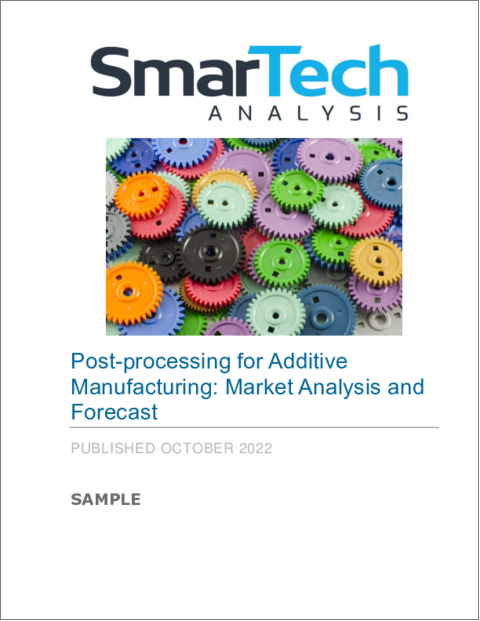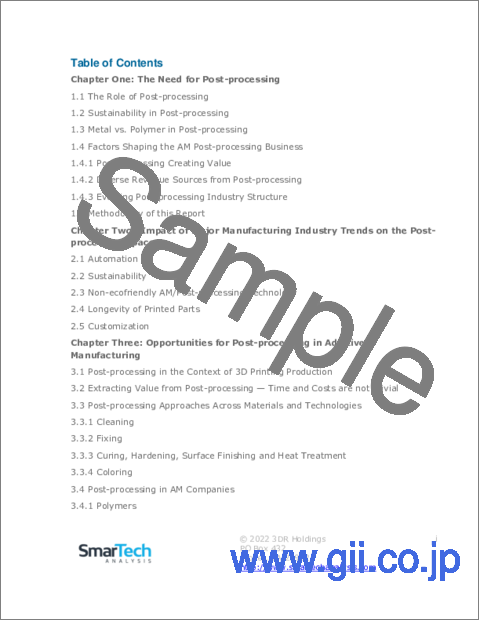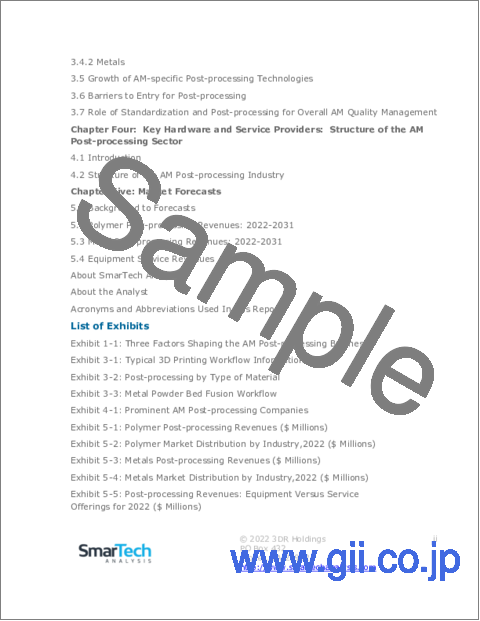|
|
市場調査レポート
商品コード
1134397
積層造形 (AM) 後処理:市場の分析と予測Post-Processing for Additive Manufacturing: Market Analysis and Forecast |
||||||
| 積層造形 (AM) 後処理:市場の分析と予測 |
|
出版日: 2022年10月07日
発行: Additive Manufacturing Research
ページ情報: 英文 37 Pages
納期: 即納可能
|
- 全表示
- 概要
- 目次
材料や印刷技術の向上により、現在の積層造形 (AM) のコストや技術力でも、新しい用途に手が届くようになってきました。このプロセスを後押ししている要素のひとつに、さまざまな印刷方式に対応した後処理技術の成熟があります。今のところ、AMは最終製品の製造市場全体のごく一部に過ぎませんが、その割合は増え続けています。
ほぼすべての3Dプリント作業において、サポート、余分な粉末、または基本的な硬化を除去するために、ある程度の後処理が必要です。しかし、この業界では、表面粗さや材料性能など、AMパーツの既知の欠点をターゲットにした印刷固有のオペレーションが進化しています。
当レポートでは、世界の積層造形 (AM) 後処理 (洗浄、着色、表面仕上げ、硬化、熱処理など) の市場について分析し、今までは重要ながら見過ごされてきた後処理が3Dプリントで重視されるようになった経緯や、市場の主な機会と課題、業界の基本構造、全体的な市場規模・成長率の動向見通し、主要企業のプロファイルなどを調査しております。
目次
第1章 後処理の必要性
- 後処理の役割
- 後処理における持続可能性
- 後処理における金属とポリマー
- AM後処理ビジネスの形成要因
- 後処理の価値創造
- 後処理からの多様な収入源
- 後処理産業の構造の進化
- 当レポートの調査手法
第2章 製造業の主要動向が後処理スペースに与える影響
- オートメーション
- 持続可能性
- 環境にやさしくないAM/後処理技術
- プリント部品の寿命
- カスタマイズ
第3章 積層造形 (AM) における後処理の機会
- 3Dプリント生産における後処理
- 後処理からの価値創出:時間とコストの重要性
- 材料・技術横断型の後処理アプローチ
- クリーニング
- 固定
- 養生・硬化・表面仕上げ・熱処理
- 着色
- AM企業における後処理
- ポリマー
- 金属
- AM固有の後処理技術の成長
- 後処理の参入障壁
- AM品質管理全体における標準化と後処理の役割
第4章 主要なハードウェア・サービスプロバイダー:AM後処理業界の構造
- イントロダクション
- AM後処理産業の構造
第5章 市場予測
- 業績予想の背景事情
- ポリマー後処理の収益 (2022年~2031年)
- 金属後処理の収益 (2022年~2031年)
- 設備サービス収入
SmarTech Analysisについて
アナリストについて
当レポートで使用される頭字語と略語
This report provides the reader with a detailed understanding of the changing market dynamics that are causing additional emphasis of these operational steps, a review of the top suppliers of post-processing equipment and services, and a series of market forecasts examining year over year trends and industry breakdowns. The report is authored by Mike Vasquez, PhD, founder of noted industry consultancy 3Degrees.
The report also details the roles and requirements for 3D printing post-processing, a critical yet often overlooked part of the overall additive manufacturing workflow. The term encompasses a broad set of operations after any part comes out of the printer. This can include cleaning, coloring, surface finishing, curing, heat treating, and other manufacturing operations.
As materials and printing technologies have improved, new applications are within reach of the current cost and technical capabilities of additive manufacturing. One element that has helped to move this process along is the maturation of post-processing technologies for a variety of Additive Manufacturing printing modalities. For now, AM represents a small portion of the overall end-product manufacturing market, but that portion is growing.
In nearly all 3D-printing operations some amount of post processing is required to remove supports, excess powder, or basic curing. However, the industry has seen the evolution of printing-specific operations that target known shortcomings of AM parts, like surface roughness or material performance.
This report surveys the major companies providing services and products to directly target the post-processing operations involved in additive manufacturing, including but not limited to: AM-FLOW, AMT, DyeMansion, PostProcess, Solukon, Bel Air Finishing, Gasbarre, Hiperbaric, and MicroTek Finishing.
Table of Contents
Chapter One: The Need for Post-processing
- 1.1. The Role of Post-processing
- 1.2. Sustainability in Post-processing
- 1.3. Metal vs. Polymer in Post-processing
- 1.4. Factors Shaping the AM Post-processing Business
- 1.4.1. Post-processing Creating Value
- 1.4.2. Diverse Revenue Sources from Post-processing
- 1.4.3. Evolving Post-processing Industry Structure
- 1.5. Methodology of this Report
Chapter Two: Impact of Major Manufacturing Industry Trends on the Post-processing Space
- 2.1. Automation
- 2.2. Sustainability
- 2.3. Non-ecofriendly AM/Post-processing Technology
- 2.4. Longevity of Printed Parts
- 2.5. Customization
Chapter Three: Opportunities for Post-processing in Additive Manufacturing
- 3.1. Post-processing in the Context of 3D Printing Production
- 3.2. Extracting Value from Post-processing - Time and Costs are not Trivial
- 3.3. Post-processing Approaches Across Materials and Technologies
- 3.3.1. Cleaning
- 3.3.2. Fixing
- 3.3.3. Curing, Hardening, Surface Finishing and Heat Treatment
- 3.3.4. Coloring
- 3.4. Post-processing in AM Companies
- 3.4.1. Polymers
- 3.4.2. Metals
- 3.5. Growth of AM-specific Post-processing Technologies
- 3.6. Barriers to Entry for Post-processing
- 3.7. Role of Standardization and Post-processing for Overall AM Quality Management
Chapter Four: Key Hardware and Service Providers: Structure of the AM Post-processing Sector
- 4.1. Introduction
- 4.2. Structure of the AM Post-processing Industry
Chapter Five: Market Forecasts
- 5.1. Background to Forecasts
- 5.2. Polymer Post-processing Revenues: 2022-2031
- 5.3. Metal Post-processing Revenues: 2022-2031
- 5.4. Equipment Service Revenues
About SmarTech Analysis
About the Analyst
Acronyms and Abbreviations Used In this Report
List of Exhibits
- Exhibit 1-1: Three Factors Shaping the AM Post Processing Business
- Exhibit 3-1: Typical 3D Printing Workflow Information
- Exhibit 3-2: Post-processing by Type of Material
- Exhibit 3-3: Metal Powder Bed Fusion Workflow
- Exhibit 4-1: Prominent AM Post-processing Companies
- Exhibit 5-1: Polymer Post-processing Revenues ($ Millions)




